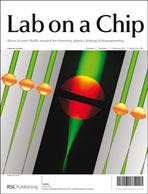Electromagnetic liquid pistons for capillarity-based pumping†
Abstract
The small scales associated with lab-on-a-chip technologies lend themselves well to capillarity-dominated phenomena. We demonstrate a new capillarity-dominated system where two adjoining ferrofluid droplets can behave as an electronically-controlled oscillator or switch by an appropriate balance of magnetic, capillary, and inertial forces. Their oscillatory motion can be exploited to displace a surrounding liquid (akin to an axial piston pump), forming electromagnetic “liquid pistons.” Such ferrofluid pistons can pump a precise volume of liquid via finely tunable amplitudes (cf.pump stroke) or resonant frequencies (cf.pump speed) with no solid moving parts for long-term operation without wear in a small device. Furthermore, the rapid propagation of electromagnetic fields and the favorable scaling of capillary forces with size permit micron sized devices with very fast operating speeds (∼kHz). The pumping dynamics and performance of these liquid pistons is explored, with experimental measurements showing good agreement with a spherical cap model. While these liquid pistons may find numerous applications in micro- and mesoscale fluidic devices (e.g., remotely activated


 Please wait while we load your content...
Please wait while we load your content...